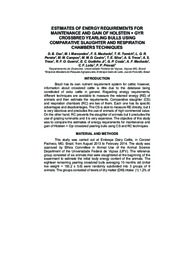Estimates of energy requirements for maintenance and gain of Holstein x Gyr crossbred yearling bulls using comparative slaughter and respiration chambers techniques.
Estimates of energy requirements for maintenance and gain of Holstein x Gyr crossbred yearling bulls using comparative slaughter and respiration chambers techniques.
Author(s): OSS, D. B.; MARCONDES, M. I.; MACHADO, F. S.; TOMICH, T. R.; PEREIRA, L. G. R.; CAMPOS, M. M.; CASTRO, M. M. D.; SILVA, T. E.; TRECE, A. S.; GUERRA, R. F. O.; GODINHO JR, E. C.; COSTA, G. P.; MACHADO, A. F.; LOBO, C. F.; PROVAZI, F. P.
Summary: Brazil has its own nutrient requirement system for cattle; however, information about crossbred cattle is little due to the database being constituted of zebu cattle in general. Regarding energy requirements, different techniques are available to measure the retained energy (RE) of animals and then estimate the requirements. Comparative slaughter (CS) and respiration chambers (RC) are two of them. Each one has its specific advantages and disadvantages. The CS is able to measure RE directly, but it is very laborious and precludes the use of animals of high commercial value. On the other hand, RC prevents the slaughter of animals but it precludes the use of grazing ruminants and it is very expensive. The objective of this study was to compare the estimates of energy requirements for maintenance and gain of Holstein × Gyr crossbred yearling bulls using CS and RC techniques.
Publication year: 2015
Types of publication: Paper in annals and proceedings
Unit: Embrapa Dairy Cattle
Keywords: Crossbred cattle
Observation
Some of Embrapa's publications are published as ePub files. To read them, use or download one of the following free software options to your computer or mobile device. Android: Google Play Books; IOS: iBooks; Windows and Linux: Calibre.
Access other publications
Access the Agricultural Research Database (BDPA) to consult Embrapa's full library collection and records.
Visit Embrapa Bookstore to purchase books and other publications sold by Embrapa.

